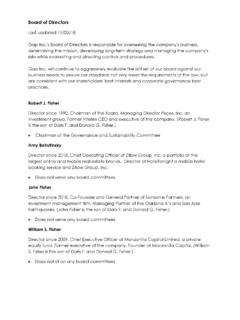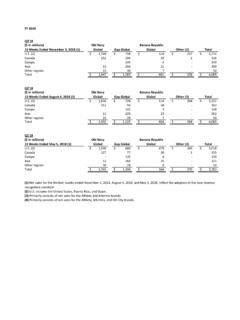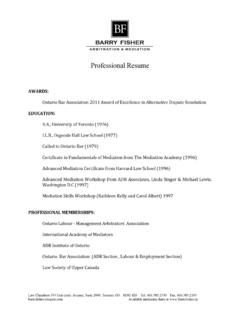Transcription of Don Fisher, 1928–2009
1 don fisher , 1928 2009 Gap Inc. FounderDon and Doris fisher founded and then transformed a single store in San Francisco stocked with Levi s, records and tapes into a thriving, nearly $15 billion global business with more than 134,000 employees, more than 3,100 stores and a permanent place in pop cultural history. They have been credited with inventing the specialty retail category, though they were equally known for their commitment to philanthropy and civic his distinguished career, Don kept a sharp focus on growing Gap Inc. thoughtfully, but always main-tained a commitment to his family, his philanthropic and civic duties and his love of the had never anticipated that his once small business would grow so rapidly, that it would revolutionize retail and transcend cultures.
2 He d always envisioned a modest chain of casual wear stores maybe, as he once put it, as many as 10. His approach was led by passion and determination doing things his own way. The first Gap store, in 1969, would change retail forever. Our company continues to demonstrate values that, from the beginning, set us apart creativity, risk-taking, integrity, loyalty, doing what s right and staying focused on our customers, Don during his final months, Don, wearing his trademark knotted sweater over a sharp dress shirt and pressed khakis, was a frequent presence at company headquarters in San Francisco, where he kept an office. He visited stores Inc. CEO Glenn Murphy spoke often about how Don, despite his many accomplishments, remained fully engaged to the company he loved always asking the toughest questions during board in 2009, Don and Doris spoke to Gap Brand store leaders and headquarters employees earning a rousing ovation as they entered the room each time.
3 I look at running a store and running a business as playing a game, he told the store leaders, in January 2009. And what do you do when you want to play a game? You want to win. Growing upDon was a third-generation San Franciscan. His great-grandfather, Samuel fisher , arrived in San Francisco, from New York, in the 1860s a decade after the discovery of gold transformed was born to Sydney and Aileen fisher , on Sept. 3, 1928. He was the first of three boys. He had always consid-ered himself extremely fortunate to have such good his father, a cabinetmaker, Don learned the nuances of running a business he was strongly encouraged to take risks. Change or fail would become one of Don s most famous quotes.
4 He d described Aileen as having a no-nonsense approach to life, a loving woman who encouraged her sons to make practical, smart decisions. She d imparted a number of family expressions that stuck in Don s head: never say no when you can say yes. Don had a comfortable, middle class upbringing, growing up in an attractive, two-story house in San Francisco s Sea Cliff neighborhood. He had a great view of the Bay. Don recalled watching the Golden Gate Bridge get built, in the mid 1930s, cable by cable. He especially enjoyed weekend trips to Stinson Beach, where he d found his love of the open water. He d often swim and fish there with his brothers. As he grew up, he became an accomplished swimmer eventually serving as captain of both the swim and water polo teams while a senior at UC Berkeley (Cal).
5 At Cal, Don earned four varsity letters in swimming and another three in water polo, a remarkable accomplish-ment. He d learned different strokes and swimming styles as early as moved through San Francisco s public school system, finishing at Lowell High School, where he was a top competitive swimmer. While there, he broke the 50-yard, city free-style record his junior attended UC Berkeley, where he was a member of Delta Kappa Epsilon fraternity and from which he gradu-ated, in 1951, with a Bachelor of Science degree in Business Administration. He didn t have to look far for a career opportunity; it was right there in his few years earlier, his mother, Aileen, had inherited a family business, L.
6 & E. Emanuel Incorporated, a mill and cabinet making firm, after her father had died. Relatives had founded the company in business, which had supplied custom product showcases to such customers as Macy s, was positioned as a future for Don and his brothers. But while taking an investments and real estate course at Cal, Don was struck by a fascinating professor who had filled his head with exciting ideas ideas that didn t involve the family college, Don served as a Naval Reserve officer; with a mind full of brewing ideas, he worked for his father in the cabinet-making business. Don was an accomplished swimmer whose determination would suit him well in , he was determined to branch out on his own, to create his own future eventually pursuing real estate, building spec homes and converting old hotels into residences for seniors.
7 He never shied away from the possibil-ity of failure, constantly pushing himself to discover something after college, Don s life would be forever altered. That s when he married his true soul-mate, Doris Feigenbaum, a long-time family a personal letter Don wrote to share with special guests and family members during an intimate party to recognize the company s 40th birthday, in August, he described marrying Doris as the best decision I ever made. The path to GapWhile Don both failed and succeeded as an entrepreneur during the 1950s and 60s, something stirred in him. He had always sought a business that wouldn t just pay the bills but excite, no matter the sector.
8 Something was going to happen. He just didn t know what it would be. I wondered just how smart I d been, and just how lucky I would be, Don said. I always felt it took a little luck to get ahead, but it never occurred to me that the formula for success might necessarily involve both kinds of luck good and bad. Without bad luck, in fact, there wouldn t have been a Gap. It took a confluence of random happenings that led to the concept and finally the first physical store to materialize and transform the retail landscape for the mid-1960s, Don, who had been working with his father, Sydney, branched out to start his own business: refurbishing old hotels. He bought the Capitol Park Hotel in Sacramento the first in a series of lucky happen-ings that would change his buying the building, he leased space to a Levi s salesman, who opened a fisher , 1928-20092 I enjoyed the energy the showroom brought to this old hotel, Don said.
9 America had a long and loyal romance with Levi products, especially Levi s historic original 501 blue jeans. Don shared that enthusiasm; he d grown up wearing the jeans. He began to mull over ideas, talking with the salesman about the apparel right size pantsOne day, Don decided to buy a handful of jeans and slacks from the salesman. The product arrived from a distribution center. When he tried on the pants, none fit. He needed a 34-waist, 31-length. All the pants had 30-inch he asked if the salesman would exchange the pants for the correct sizes. He hesitated, saying it would be a paperwork nightmare. But the salesman suggested exchanging the pants at a city department took him up on the idea, and asked Doris to pay a visit to Macy s, in San Francisco.
10 She found a Levi s display table in the basement and cringed at the mess. But she sorted through the items and reported back to Don. They carried only even sizes, about five pair in each size category: 34 x 32, 36 x 32 and so on, he tried another floor. Same problem. He tried another department store, The Emporium. Again, no luck. What if, Don had mused, someone put together all the styles, colors and sizes Levi Strauss had to offer in one store? The first GapThat led to the creation of the first Gap store, on Ocean Avenue, which, until Doris struck gold with the name, was going to be called Pants and Discs. The Gap was inspired by the idea of The Generation Gap.







